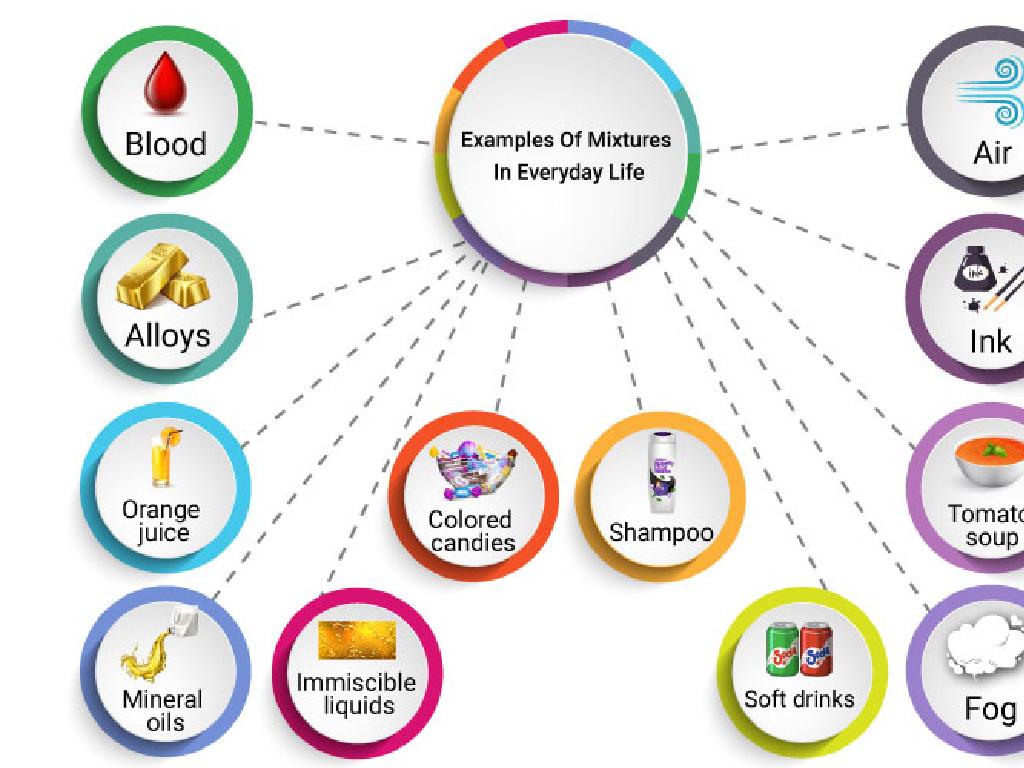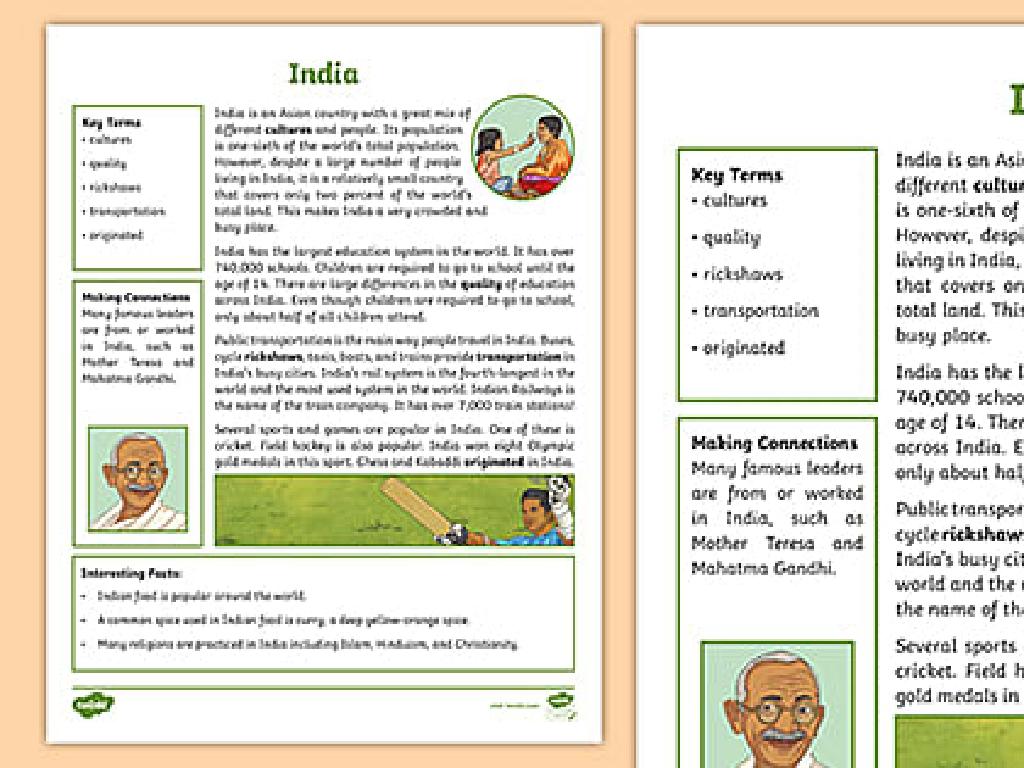Multiply 1-Digit Numbers By 2-Digit Numbers: Multi-Step Word Problems
Subject: Math
Grade: Fourth grade
Topic: Multiply By One-Digit Numbers
Please LOG IN to download the presentation. Access is available to registered users only.
View More Content
Welcome to Multiplication!
– Multiplication as repeated addition
– If you have 4 bags with 3 apples each, 4 times 3 apples equals 12 apples.
– Power of multiplication in math
– It helps us solve problems quickly without adding repeatedly.
– Solving multi-step problems
– Break down the problem into smaller steps and solve each part.
– Practice with real-world examples
– Imagine buying 3 packs of stickers, with 15 stickers in each pack.
|
This slide introduces students to the concept of multiplication as a form of repeated addition, which is a foundational skill in mathematics. Emphasize the efficiency of multiplication over addition for larger quantities. Encourage students to think of multiplication as a shortcut to adding the same number multiple times. Provide examples of multi-step word problems and demonstrate how to approach them by breaking them down into manageable parts. Use relatable scenarios, such as buying multiple items, to illustrate the practical use of multiplication in everyday life. Instruct students to practice with similar examples and prepare them for more complex problems as they progress.
Multiplication Basics: Stepping Up to Multi-Step Problems
– Review: What is multiplication?
– Multiplication combines equal groups into a total
– Practice: 1-digit x 1-digit examples
– Examples like 3 x 4 show simple multiplication
– Understanding multiplication as repeated addition
– If you have 4 groups of 3, that’s 3+3+3+3
– Preparing for multi-step word problems
|
Begin with a quick review of multiplication, ensuring students recall that it’s a method to combine equal groups. Use simple 1-digit by 1-digit multiplication examples to refresh their memory. Explain multiplication as repeated addition to solidify their understanding, which is crucial for tackling more complex problems. This foundation is essential for today’s lesson on multi-step word problems involving 1-digit by 2-digit numbers. Encourage students to think of real-life scenarios where they group items, like packs of pencils or sets of stickers, to illustrate the concept.
Breaking Down Multi-Step Problems
– Approach multi-step problems
– Read carefully, identify what’s being asked
– Find numbers to multiply
– Look for the two numbers that you’ll multiply
– Comprehend the question
– Understand what the problem wants you to find
– Solve step by step
– Tackle each part of the problem one at a time
|
When teaching students to handle multi-step word problems, start by guiding them to read the problem thoroughly and understand the scenario. Encourage them to underline or highlight the numbers involved and the specific question that needs to be answered. Discuss strategies for identifying the relevant information and disregarding any unnecessary details. Then, demonstrate how to organize their work by solving each part of the problem in a step-by-step manner, ensuring they understand each phase before moving on to the next. Provide examples and practice problems to solidify their understanding.
Let’s Multiply: 1-Digit by 2-Digit Numbers
– Multiply single and double digits
– Use place value for multiplication
– Break down the number 12 into 10 (tens place) and 2 (ones place)
– Example: Multiply 4 by 12
– 4 times 12 is like 4 times (10 + 2)
– Solve 4 x 12 step by step
– We’ll multiply 4 by 10 and 4 by 2, then add the results
|
This slide introduces students to the concept of multiplying a 1-digit number by a 2-digit number using place value. Start by explaining that multiplication is similar to adding a number to itself multiple times. Emphasize the importance of place value by breaking down the 2-digit number into tens and ones. Use the example of 4 x 12 to show this process in action: multiply 4 by 10 to get 40, then multiply 4 by 2 to get 8, and finally add 40 and 8 to get 48. Encourage students to practice this method with different numbers and provide guidance as needed. This approach helps students understand the logic behind multiplication and prepares them for more complex problems.
Class Practice: Multiplying Numbers
– Solve 3 x 24 together
– Break it down: 3 x 20 and 3 x 4, then add the results.
– Work through 7 x 15 as a class
– Start with 7 x 10 and 7 x 5, combine the products.
– Discuss steps for solving
– Share different solving methods
|
This slide is aimed at engaging the class in solving multi-step multiplication problems together. Start by demonstrating the process of multiplying a one-digit number by a two-digit number using the examples provided. Encourage students to participate by breaking down the problems into easier steps, such as multiplying the one-digit number by the tens and then by the ones place separately, before adding the two products together. Discuss different methods that can be used to solve these problems, such as the distributive property or drawing an area model. Provide guidance and support as needed, and ensure that each student understands the process before moving on to independent practice.
Multiplying in the Real World: Word Problems
– Apply multiplication to real life
– Read problems with attention
– Example: Lemonade stand sales
– If 1 glass costs $2 and you sell 35, how much do you earn?
– Step-by-step problem solution
– Multiply $2 (1 glass) by 35 (glasses sold) to find total earnings.
|
This slide aims to help students apply their multiplication skills to solve real-world problems. Emphasize the importance of reading the problem carefully to understand what is being asked. Use the example of a lemonade stand to make the problem relatable. Show how to break down the problem into smaller steps, such as identifying the cost per item and the total number of items, then multiplying these together to find the solution. Encourage students to visualize the problem and write down each step of their solution process. This will help them tackle more complex multi-step word problems with confidence.
Group Activity: Solving Word Problems
– Split into groups for word problems
– Each group solves a unique problem
– Explain your problem-solving steps
– Share how you figured out the answer
– Discuss various methods used
– Compare different strategies and learn from each other
|
This group activity is designed to encourage collaborative problem-solving and discussion among students. Each group will receive a different multi-step word problem involving the multiplication of 1-digit numbers by 2-digit numbers. After solving their assigned problem, they will explain their approach to the class, detailing each step taken to arrive at the solution. This will help students articulate their thought process and reinforce their understanding. Following the presentations, lead a discussion on the different methods used by each group, highlighting the benefits of various strategies. This will allow students to see multiple approaches to solving the same type of problem, which can deepen their understanding and provide them with alternative methods to try in the future. Possible activities could include problems related to real-life scenarios such as shopping, cooking, or building, which can make the exercise more engaging and relatable.
Class Activity: Multiplication Scavenger Hunt
– Find grouped objects in class
– Calculate total items using multiplication
– If there are 5 sets of 4 pencils, 5 x 4 equals how many pencils?
– Present your findings
– Collaborate and learn
– Work with classmates to solve problems
|
This interactive activity is designed to help students apply their knowledge of multiplication in a fun and engaging way. Students will search the classroom for objects that are grouped, such as pencils in a cup or books on a shelf, and use multiplication to determine the total number of items. After calculating, they will present their findings to the class, explaining how they used multiplication to get their answers. Encourage students to work together and discuss different strategies for solving the problems. Possible variations of the activity could include: 1) Timing the scavenger hunt for added excitement, 2) Having students create their own multiplication word problems based on the items they find, 3) Incorporating a drawing or diagram component where students visually represent the groups they’ve multiplied.
Wrapping Up: Multiplication Mastery
– Review of multiplication steps
– Practice makes perfect
Regular practice helps solidify the multiplication skills learned today.
– Homework: Multiplication sheet
Solve the problems on the worksheet to reinforce today’s lesson.
– Keep practicing at home!
|
As we conclude today’s lesson on multiplying 1-digit numbers by 2-digit numbers, it’s crucial to emphasize the importance of practice in mastering these skills. The homework assignment is a multiplication worksheet that will provide students with additional practice to reinforce the concepts learned in class. Encourage students to attempt the worksheet independently, reminding them that making mistakes is a part of the learning process. Offer to provide assistance during the next class for any questions they may have while completing the homework. Remember to praise their efforts and progress to boost their confidence in solving multi-step word problems.






